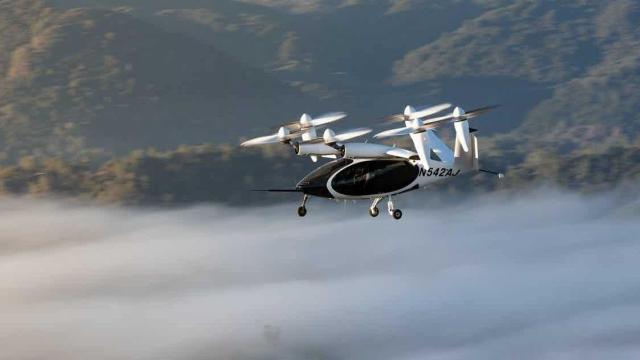Have you ever imagined getting to the airport in a flying taxi, soaring over the chumps who are stuck in traffic below? It’s been a dream of the future for decades. But the New York Times says it could be coming soon. Again.
Yes, it’s flying taxi season, something that comes around like clockwork every six months or so — especially during a holiday week when the news might be slow. You’ll notice Thanksgiving is a just a few days away, something that we’re sure is merely a coincidence.
The New York Times published a new article this morning titled, “Taxi! To the Airport — by Air, Please,” by Gautham Nagesh, and it reads like something that could’ve been published at any point since the 1950s (or even the 1920s) in any newspaper in America.
The formula is often the same: The article opens by painting a picture of tomorrow for the reader. And this version of the future happens to be in Manhattan:
It is late afternoon in Manhattan and you have a flight to catch at Kennedy International Airport. Instead of sitting in rush-hour traffic for two hours, you take a short ride to a nearby parking garage where you board an electric aircraft that takes off vertically from the roof and deposits you at Kennedy 20 minutes later for roughly the same cost as a fancy ride-share. You make your flight in time.
Then the author tells you it might sound a little like science fiction, but it’s going to be your future! For real this time!
While this scenario might sound far-fetched, several companies say they are on the verge of being able to offer safe, cheap, clean electric aircraft that can help passengers travel distances between two and 241 km without the need for a conventional runway. Public and private experts believe the technology could grow into a massive market that helps ease congestion and changes the way people travel in major metropolitan areas.
Newspapers, including the New York Times, are filled with this formula. As just one example, check out this article from 1996 about the year 2006. But there are different variations each time, of course.
In this version, there’s a focus on the electricity that powers these vertical take off and landing vehicles. And that makes a lot of sense, given the fact that nobody wants their version of the future to be using gasoline anymore. Futurists of the 1950s would be shocked we’re still using oil:
While urban air travel is currently out of reach for most customers (think: Uber Copter), improvements in battery technology have driven down the cost of developing electric-powered aircraft that are viable as urban passenger transportation. These companies are betting they can bring electric urban and regional air travel to the masses, and have developed new aircraft to compete for a slice of this nascent market within the next few years.
The writer of this piece is also keenly aware of the fact that technologies like this would almost certainly cater to the ultra-wealthy, something that often got lost in the discussion of futurism during the 20th century. But this won’t just be for the uber-rich, according to the people quoted in the article.
“We want to create something that is available to a lot of people, that can do the job of a high-speed train without requiring the infrastructure,” said Daniel Wiegand, chief executive and founder of Lilium Air Mobility, based in Germany. “We won’t be at the ticket price of a high-speed train in Germany on our first day, but if we don’t get there within 15 years I would consider our mission failed.”
When are we supposed to be getting this fantastic new technology? It’s going to be here by 2024, which, if you look at the calendar, is less than three years away. Terms and conditions apply, of course.
The more established players in this space, like Joby Aviation and Volocopter, are promising to have aircraft in service by 2024, an ambitious goal that will depend largely on gaining regulatory approval.
The rest of the article is roughly what you’d expect, and you can read it all at the New York Times. The piece includes the word “disrupting,” though it’s not in a positive sense, which is another subtle change from the futurism of the 2010s.
Sam Morrissey, the executive director of Urban Movement Labs, said the aircraft initially will likely be confined to existing commercial airports and flight paths until officials are able to determine how the new locations for takeoffs and landings can be added without disrupting other modes of transport.
Don’t get us wrong. We’d love to see a fuel-efficient version of the flying car dreams that we’ve been waiting on our entire lives become a tangible reality. But maybe don’t get your hopes up that we’ll be zipping around the skies for peanuts anytime soon. We’ve been hearing that flying cars are just two years away forever. And there are still many, many hurdles to overcome.
We’ll believe it when we see it.
